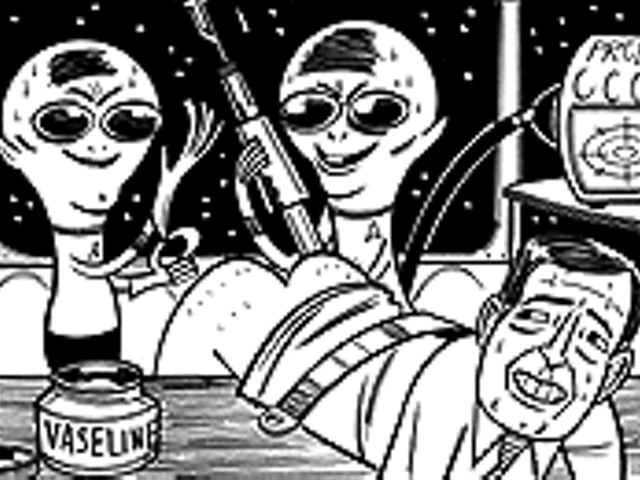Benetton is the Italian fashion giant known for putting startling images on billboards, in magazine ads and in glossy ad supplements. Examples include a 1989 photo of a black woman breastfeeding a white infant, a 1991 shot of a priest and a nun kissing and a 1994 faces-of-AIDS campaign. During the World Cup, a Benetton ad featured two soccer balls in a condom as part of the company's ongoing "AIDS-Safer Sex" campaign. One ad, relating to race, showed three virtually identical human hearts, surgically removed, labeled "white," "black" and "yellow."
So why does Benetton do this? Nixon says it's to sell clothes. But how does printing a 96-page ad supplement as part of an anti-death-penalty campaign (which took three years and $20 million to produce) sell sweaters and shirts? Well, most clothes perform the same function, so a company seeks an advantage by linking its logo to an edgy, world-wise image. You buy the product, you buy the identity, or at least that's the theory. So it's a publicity stunt with a moral.
The "We, on Death Row," supplement appeared in the current issue of Talk magazine, Tina Brown's latest example of how she can run an interesting magazine as long as she's allowed to lose millions of dollars (previous example: The New Yorker). The photos depict convicted murderers on death row. Several are from Missouri, including Jerome Mallett, convicted of killing Missouri state trooper James Froemsdorf. This inclusion particularly pissed off Nixon.
"I saw that line in there that quotes one of the guys, "The problem with our society is that fathers aren't spending enough time with their kids.' Then you flip two pages later and you got a picture of Jerome Mallett, who shot Trooper Froemsdorf, and his three kids have grown up for the last 15 years with no dad -- that's surreal," says Nixon. So why didn't Nixon just ignore it? Isn't he falling for the stunt by beating the drum about this?
"I certainly hope this doesn't cause people to go out and buy Benetton sweaters," says Nixon. "Somebody needs to speak out -- they're sending out 600,000 copies of this advertising all over the country; they're talking about billboards." Nixon says he has launched an investigation to find out how Benetton obtained the photos and interviews. He says the photographer and interviewer claimed they were doing a documentary. Maybe someone should have become suspicious when prisoners were told to change out of their Gap T-shirts.
"If they had told the truth about what they were doing, they would not have had the access to do what they did," Nixon says. "We do not sell the pictures of death-row inmates to benefit private companies." The legal strategy here is to prove that deception was used and to file a civil suit to prevent the company from profiting by it. "I'm not an advertising expert, but Nike has all sorts of ads with a goofy picture with just its swoosh logo down in the corner," Nixon says.
Nixon's Jan. 28 letter to the "Chief Executive Officer, Benetton Group SpA," in Treviso, Italy, charged that the campaign was "launched on the backs of innocent victims." A Feb. 2 press release from Nixon stated that the campaign was "glorifying convicted murderers" and that Benetton had misled prison officials to gain access to interview and photograph prisoners. TV news dutifully picked up the baton from there, and the St. Louis Post-Dispatch followed with an above-the-fold Page One piece reiterating Nixon's outrage. The Benetton execs must be chuckling all the way from death row. That 20 mil was well spent.
To those in the trenches of the anti-death-penalty struggle, the Benetton ad blitz isn't necessarily seen as a positive. The Rev. Paul Beins, chaplain at the St. Louis city jail for 28 years, fears the controversy might counteract the recent progress in Illinois, where Gov. George Ryan declared a moratorium on executions as a result of the reversal of several death-row cases.
"I thought that was great. The Illinois governor is saying, "Hold it a minute.' He's not saying he's opposed to execution, he's just saying, "Are we killing the right people?' That to me, is very important," says Beins, who has retired from his work at the city jail but remains active in Missourians Against the Death Penalty. Beins worries that the current flap will trigger Missouri legislators to do some grandstanding to prove they're not weak on crime. "I don't know how our legislators are going to react to it," says Beins. "That's the hassle I've got right now."
BLACKOUT AT THE SUPER BOWL: With the Post-Dispatch sending 29 people to the Super Bowl, management must have thought it had all its bases covered. But no, once the troops had landed in Atlanta, an uproar of sorts surfaced back on Tucker Boulevard. Of all those sent to cover the Rams-Titans game, only one was an African-American. That was Gary Hairlson, a photo editor.
A memo to this effect, protesting the oversight, circulated in the newsroom. So who was drafted? The affable Greg Freeman, of course, who apparently serves as a sort of a utility infielder for the daily paper of record. Columnist, radio host, TV host, traveling sports-spectacle columnist.
"I was asked late," says Freeman, admitting "it could have been" because of the discovery that Hairlson was the only black P-D employee at the game. "I was asked on Tuesday, and I was on a plane Wednesday," Freeman says. "You can draw whatever conclusions you want from that."
Arnie Robbins, managing editor of the P-D, admits as much.
"There was some concern expressed that we did not have a very large contingent of African-American staff members," he says, referring to the "contingent" of one before Freeman was sent. Robbins points to the inclusion of a photographer of Asian ancestry and notes that two other management people coordinating coverage in Atlanta were women, but he says he regrets that the omission wasn't caught earlier. "We wished we had given a little more thought to that," Robbins says. "So we did think about that."
Thank God for Freeman. "I was very, very glad that Greg Freeman wrote very good columns that were very different than what the sportswriters were doing, that were more about the city of Atlanta and the city of St. Louis, how they handled such a big event and what it might mean if we ever got a Super Bowl here and so on and so forth," Robbins says.
It's all a byproduct of a lack of diversity, something that most publications suffer from -- including The Riverfront Times (which has a nonwhite editor but no African-American staff writers or editors). "It's a reflection of that fact that we and many newspapers of our size don't have enough diversity on our staffs," says Robbins. "You always want more diversity. You get better coverage when you have more diversity, whether it's age, sex, race, experience -- all those things add to richness of coverage. So yeah, from now on my antennae are up, definitely."
Meanwhile, there's Freeman. What a burden for Greg to bear.
MY DINNER WITH GEORGIA, BY BERNIE MIKLASZ: With 3,000 or more journalists covering the Super Bowl, there had to be some misfires. In the Los Angeles Times, columnist T.J. Simers claimed that the "No. 1" sports columnist in St. Louis dined every Thursday night with Rams owner Georgia Frontiere. The implication was that the columnist was in the owner's back pocket.
Of course, the anonymous columnist Simers referred to was the Post-Dispatch's Bernie Miklasz. Miklasz denies chowing down with Frontiere on a weekly basis, though he says they ate together about five times this season, at Gian-Peppe's on the Hill. "I didn't go every Thursday night, but even if I did I wouldn't apologize for it, because you learn a lot of good things during those sessions, because it's not just her," says Miklasz, adding that others at the table included Rams president John Shaw and front-office types Jay Zygmunt and Charley Armey.
Miklasz says he told Simers that he should have called to check out the story, because he had nothing to hide.
"I'm always flattered I get mentioned so many times in the Times," Miklasz says. "I always thought the big sophisticated paper wasn't supposed to care about some fat sportswriter at a medium-sized paper. It's pretty good."
Hanging out with the owner and her hirelings in a social setting didn't suck him in too close to the group, Miklasz insists -- he still ripped the Rams when he thought it was needed. It's just that this year, nearly everything went well. As for the town Frontiere left behind, there are some bitter feelings.
"The LA guys are playing for the crowd, which is fine -- just like I ripped (Bill) Bidwill after he moved. You have to throw red meat to the masses a little bit. It all depends on what your criteria is for ownership," says Miklasz. "She's a hands-off owner, which I kind of think are the best kind."
Give us your feedback by e-mailing "Short Cuts" at [email protected], faxing 615-6716 or calling 615-6711.





